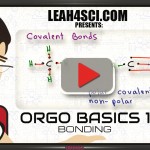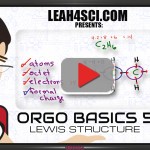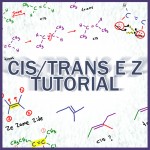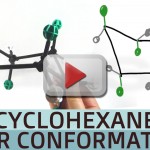This video shows you a quick, time-saving checklist for radicals in Lewis structures! It ensures you don’t miss anything when deciding WHICH atom most likely has the radical. You’ll also see it in action as it is applied to several examples. For even more on radicals, read Free Radicals in Organic Chemistry – Reactions, Resonance, Stability, […]
Sp3, Sp2 and Sp Hybridization, Geometry and Bond Angles
Sp³, sp² and sp hybridization, or the mixing of s and p orbitals which allows us to create sigma and pi bonds, is a topic we usually think we understand, only to get confused when it reappears in organic chemistry molecules and reactions. When I took general chemistry, I simply memorized a chart of geometries and […]
Ionic, Polar Covalent and Non-Polar Covalent Bonding Tutorial Video
Orgo Basics Video Series: Video 1 Your organic chemistry professor will take it for granted that you have a solid understanding of bonding. Specifically the chemical nature of ionic bonds, polar covalent and non-polar covalent bonds. These will be especially important once you start working through reactions because understanding bonds will help you recognize strong/weak […]
sp2/sp Hybridization, Bond Angle, Molecular Geometry Tutorial Video
Orgo Basics Video Series: Video 3 sp2 and sp hybrids provide organic compounds with unique shapes and reacting abilities. This video breaks down the hybridization for sp2 and sp fused orbitals using carbon and other commonly seen atoms to help you understand hybrids, geometry, and bond angles. Looking to understand molecular orbitals? Visit my Molecular Orbital […]
sp3 Hybridization, Bond Angle, Molecular Geometry Tutorial Video
Orgo Basics Video Series: Video 2 Carbon is the most common element you’ll come across in your organic chemistry course. It’s ability to bind up to 4 different atoms for a 3-dimensional structure makes it so unique and so important to organic compounds. This video helps you understand the sp3 hybridization for carbon and other […]
Lewis Structure Trick for Organic Chemistry Molecules
Orgo Basics Video Series: Video 5 Lewis structures provide you with a simple way to draw out an organic molecule showing every atom, bond, and lone electron pair. While not ideal for demonstrating bond angle and molecular geometry, it’s a great way to begin your understanding of molecules and bonding in organic chemistry. Every professor […]
Organic Chemistry or Art Class?
Wait, they never told me I needed art skills to draw organic molecules! You knew this was going to be a difficult class, and you were ready for it. You prepared to learn about atoms and electrons, reactions and mechanisms. Oh, the mechanisms! You start with Skeletal Structures, Then you get to Newman Projections, And […]
Arrhenius, Bronsted-Lowry, and Lewis Acids and Bases in Organic Chemistry
As an organic chemistry student you will find yourself faced with acid/based questions again and again. From categorizing molecules to ranking their strength without pKa or pKb values. This isn’t terrible if/when you learn it correctly, however, your professor will assume you already know this. So s/he won’t teach it. Why? Because you’re expected to remember […]
Cis Trans and E Z Geometric Isomers
Your organic chemistry course will cover many different types of isomers. Isomers have the same molecular formula but something about them is different. Geometric isomers, a type of stereoisomer, differ in their geometry or shape. This happens when substituents are LOCKED in a specific relationship to each other. I say locked because, unlike conformational isomers in […]
Cyclohexane Chair Conformations Axial and Equatorial Stability
“Why does cyclohexane have to be in a chair conformation? How do I know which carbon goes up or down?” Learn this and more in video 1 of the chair conformation series. Learn how to recognize a chair, what it represents (with a model kit and on paper) and the nature of axial and equatorial substituents. (Watch […]












